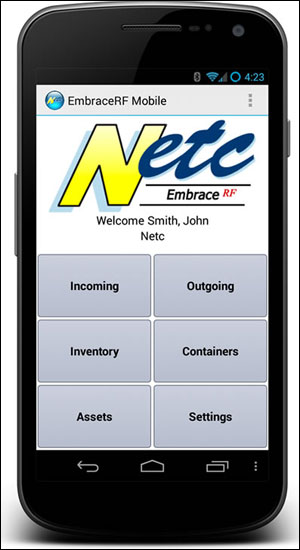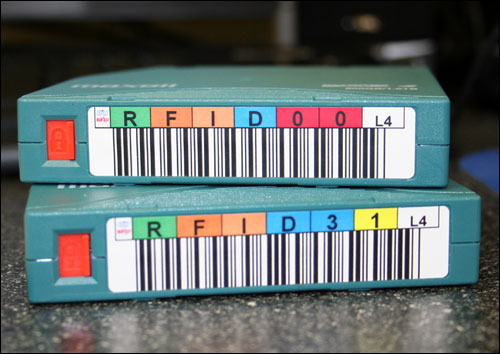Netc is marketing a new asset-management system known as EmbraceRF, that employs radio frequency identification and bar-code technologies to track storage media, IT equipment or furniture. While Netc has provided bar-code and RFID solutions for monitoring media and assets for years, the new system is designed to be easier to install and use, the company reports. Unlike previous systems requiring the use of a handheld reader and the installation of software to manage the collected read data, EmbraceRF consists of a hosted service used in conjunction with software that runs on smartphones and tablets, or on handheld or fixed readers, to access data regarding the locations and movements of tagged items. The solution includes RFID software that can be loaded onto smartphones or tablets, as well as on Motorola Solutions MC9190-Z and MC3190-Z handheld readers or Impinj fixed readers.
With the EmbraceRF solution, users will be able download a free application for their Apple iPhones or iPads, or for their Android smartphones or tablets (currently, the only version available is a demo app for Android devices). They will then be able to purchase a small Netc RFID reader that communicates with the phone via a Bluetooth connection, and pay a monthly fee to access data from the cloud-based server, via that phone or a tablet, laptop or PC.

Netc, based in Trumbull, Ct., provides bar-coded and RFID labels for the tracking of data tapes and other storage media (backup disks for archived records) at data centers or other locations. Traditionally, bar-coded labels are attached to tape cartridges to enable the locating and identifying of specific tapes in storage. In fact, Netc began offering such a bar-code-based solution in 2008. However, scanning bar codes can be time-consuming, says Al Sgambati, Netc’s cofounder and one of its two owners, and the company’s customers have been transitioning to RFID in some cases, in order to make this tracking easier.
The firm designed a bar-code label that incorporates a passive ultrahigh-frequency (UHF) RFID inlay specifically to meet the form-factor needs of tape cartridges. The inlays are made with Impinj Monza 4e chips that are embedded in a different section of the tag than the area on which the bar code is printed, thereby ensuring that the chip or antenna does not warp the bar code and affect its ability to be scanned. Without this design, Sgambati explains, the chip could add thickness to the label that would adversely affect bar-code quality. “These particular labels are placed on tape cartridges that are then inserted into a robotic library,” he says. The robot within the library then handles the tapes by reading each label’s bar code. If the label cannot be read properly, human intervention is required.
Netc supplies fixed or handheld readers loaded with the EmbraceRF software. A smartphone running the EmbraceRF mobile app, however, will be able to interrogate tags using a Bluetooth reader paired with the handset, and access that data via Netc’s cloud-based server. The phone can also receive alerts indicating if, for example, an item is missing or in the wrong location.
The EmbraceRF mobile app is intended to enable users to have data available to them on their phones, thus making use of the system simpler—whether for reading the tags or simply for accessing information regarding items in inventory. The Motorola handhelds can also access data from the EmbraceRF cloud-based server, however. In either case, users can view details from the server about the assets, as well as commission tags or take them out of service, and store data indicating what has been done.
“We’ve tried to make it very easy to deploy RFID,” Sgambati states.
Since Netc began developing EmbraceRF, the company has been speaking with customers interested in employing the technology to monitor other assets beyond storage tapes. For example, potential customers have suggested utilizing the system to track IT assets, such as computers and monitors, or furniture and other office equipment. They would simply need to purchase the tags and Bluetooth reader (newly manufactured for Netc by a third-party for this application), and pay for server access to retrieve data on their phones or other devices, says Joseph Stonoha, Netc’s other co-owner.
To date, EmbraceRF has been put to use at nine locations to track storage tapes, all located within the United States. Netc expects some customers to begin using the technology on a limited basis as a trial, with a small number of tags tracking specific assets, and to then build the system out in the future, to include additional assets with more tags.
The Bluetooth reader costs approximately $1,200, while the RFID labels cost $0.99 apiece. An EmbraceRF startup application tracking 100 assets in the cloud costs $29.95 per month, or $359 annually. This includes access to data about each tag and its reading history, as well as reporting functions in the event of an exception requiring that an alert be sent.
Customers can begin with a 100-asset program and then add additional readers and software as necessary. For example, the monthly fee for 500 tagged assets would be $53.35.
The EmbraceRF solution can also be used with Netc’s N-Case, a tagged box for transporting data tapes. The tape cartridges within the case are associated with that case’s RFID tag, thereby making the tagging and tracking of individual assets less expensive. For instance, the items stored within the case could have only bar-code labels, and be linked to the case itself.


